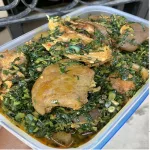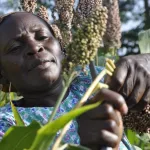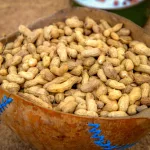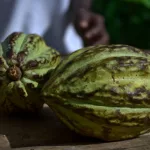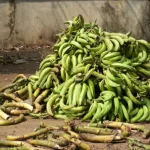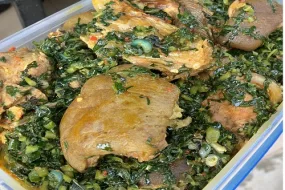What is Nigerian Maize (Corn)
Nigerian maize, commonly known as corn, is a staple crop that holds great importance in the country’s agriculture and cuisine. It’s a cereal grain that belongs to the grass family and is scientifically known as Zea mays. Maize is a versatile and widely grown crop in Nigeria, with various uses and cultural significance.

1. A Staple Food: Maize is a dietary staple for many Nigerians, particularly in the southern and middle belt regions of the country. It’s a significant source of carbohydrates and provides essential nutrients like fiber, vitamins, and minerals.
2. Traditional Cuisine: Nigerian cuisine is rich and diverse, and maize plays a crucial role in many traditional dishes. For instance, “Tuwo Masara” is a popular Nigerian dish made from maize flour and served with various soups and stews.
3. Snacks: Roasted or boiled maize on the cob is a common street snack in Nigeria. It’s often sold by street vendors and enjoyed by people of all ages.
4. Livestock Feed: In addition to human consumption, maize is also used as animal feed in Nigeria. It’s a key component in the diet of livestock like poultry, cattle, and pigs.
5. Industrial Uses: Maize serves as a raw material for various industrial products in Nigeria, including corn oil, cornstarch, and corn syrup.
6. Economic Importance: Maize cultivation is a significant contributor to Nigeria’s agricultural sector and economy. It provides employment opportunities for farmers and contributes to the country’s overall food security.
7. Cultural Significance: Maize is deeply rooted in Nigerian culture and traditions. It is often used in rituals and ceremonies and is considered a symbol of abundance and fertility.
8. Varieties: Nigeria grows various maize varieties, including yellow maize, white maize, and hybrid varieties that have been developed to increase yield and resilience.
9. Challenges: Like any crop, maize cultivation in Nigeria faces challenges such as pests, diseases, and fluctuating weather conditions. Efforts are ongoing to improve farming practices and develop more resilient maize varieties.
Overall, Nigerian maize, or corn, is a vital part of the country’s agricultural landscape and cultural heritage. It provides sustenance, livelihoods, and a taste of tradition to millions of Nigerians.
Comparative Analysis of Nigerian Maize (Corn)
Let’s compare Nigerian maize (corn) to maize from other regions to understand its unique characteristics and significance.
1. Varieties and Colors:
Nigerian Maize: Nigeria cultivates both yellow and white maize varieties. Yellow maize is more common in the southern regions, while white maize is prevalent in the northern parts.
Global Maize: Maize is grown in many countries worldwide, and the varieties and colors can vary significantly. In the United States, for example, yellow maize is the predominant type used for various purposes, including animal feed, corn syrup, and food products.
2. Culinary Uses:
Nigerian Maize: In Nigeria, maize is a staple in traditional dishes like “Tuwo Masara” and is used to make snacks such as roasted maize. It’s a vital ingredient in Nigerian cuisine.
Global Maize: In other countries, maize is used for a wide range of culinary purposes. In Mexico, for instance, maize is the key ingredient in tortillas, tamales, and various corn-based dishes.
3. Cultural Significance:
Nigerian Maize: Maize has deep cultural significance in Nigeria and is often associated with abundance, fertility, and traditional ceremonies.
Global Maize: In different cultures around the world, maize also holds cultural importance. For instance, in Native American traditions, maize is considered one of the “Three Sisters” along with beans and squash, representing sustenance and agricultural knowledge.
4. Agricultural Practices:
Nigerian Maize: Maize farming in Nigeria varies from small-scale subsistence farming to larger commercial operations. Traditional farming methods, such as manual planting and harvesting, are still prevalent in some regions.
Global Maize: In technologically advanced countries, maize farming often involves modern agricultural practices, including the use of machinery, genetically modified varieties, and precision farming techniques.
5. Economic Impact:
Nigerian Maize: Maize cultivation is a significant contributor to Nigeria’s agricultural sector and economy, providing income and employment for many farmers.
Global Maize: In countries like the United States and Brazil, maize production has a substantial economic impact, not only for domestic consumption but also for export to other countries.
6. Challenges and Opportunities:
Nigerian Maize: Nigerian maize farming faces challenges such as pest infestations, disease outbreaks, and weather fluctuations. However, there is ongoing research and development to improve maize varieties and farming practices.
Global Maize: In the global context, maize production faces challenges related to climate change, sustainability, and the need for increased yields to feed a growing world population.
Nigerian maize (corn) has its unique characteristics, culinary uses, and cultural significance within the context of Nigeria. However, when compared globally, maize takes on various forms and plays diverse roles in different cultures and economies around the world. Understanding these differences helps us appreciate the versatility and importance of maize as a global crop.
The Nutritional Properties of Nigerian Maize (Corn)
Let’s explore the nutritional properties of Nigerian maize (corn) and understand why it is a valuable component of the Nigerian diet:

Nutritional Value Of Cooked Yellow Maize/Corn
|
Quantity |
100g |
|
Calories |
135.5 kcl |
|
Fat |
1.8g |
|
Protein |
3.4g |
|
Carbohydrates |
27.7g |
1. Carbohydrates: Maize is primarily composed of carbohydrates, making it an excellent source of energy. In Nigeria, maize serves as a significant source of daily caloric intake, especially in regions where it is a dietary staple.
2. Dietary Fiber: Maize contains dietary fiber, which is essential for digestive health. It aids in regulating bowel movements, preventing constipation, and supporting overall gut health.
The Macronutrients Of Cooked Yellow Maize/Corn
|
Weight |
100g |
|
Energy |
569.9 Kj |
|
Calories |
134.5 kcl |
|
Fat |
1.9g |
|
Protein |
3.9g |
|
Carbohydrate |
26.7g |
|
Fiber |
3.9g |
|
Water |
68.9g |
3. Vitamins Components of Cooked Yellow Maize/Corn
|
Weight |
100g |
|
Vitamin A, RAE |
16μg |
|
Retinol |
NIL/mg |
|
Carotene, beta |
207μg |
|
Vitamin D |
NIL/μg |
|
Thiamin, B1 |
0.08mg |
|
Riboflavin, B2 |
0.05mg |
|
Niacin, B3 |
0.6mg |
|
|
0.2mg |
|
Folate, B9 (μg) |
7μg |
|
Vitamin B12 (μg) |
NIL/μg |
|
Vitamin C (mg) |
NIL/mg |
Vitamin A: Yellow maize, in particular, is a good source of provitamin A carotenoids, which can be converted into vitamin A in the body. This is important for maintaining healthy vision and a strong immune system.
Vitamin B Complex: Maize contains various B vitamins, including thiamin (B1), riboflavin (B2), niacin (B3), and folate (B9), which play crucial roles in metabolism, energy production, and cell growth.
4. Minerals Components of Cooked Yellow Maize/Corn
Phosphorus: Maize provides phosphorus, which is essential for bone health, cell repair, and energy metabolism.
Magnesium: Magnesium is vital for muscle and nerve function, and maize contains this mineral in moderate amounts.
|
Weight |
100g |
|
Calcium |
5.5mg |
|
Iron (Fe) |
1.4mg |
|
Magnesium |
47mg |
|
Phosphorus (P) |
91mg |
|
Potassium (k) |
89mg |
|
Sodium (Na) |
2.9mg |
|
Zinc (Zn) |
0.64mg |
|
Copper (Cu) |
0.08mg |
|
Manganese |
NIL/mg |
5. Protein:
While maize is not as protein-rich as some other grains, it still contains a moderate amount of protein. In Nigeria, maize is often complemented with protein-rich foods like legumes and meat to create balanced meals.
6. Antioxidants:
Maize contains antioxidants, including phenolic compounds, that help protect cells from damage caused by free radicals. These antioxidants contribute to overall health and well-being.
7. Calories:
Maize is calorie-dense, making it an excellent source of energy. This is especially important in regions where physically demanding work is common, as it provides the necessary fuel for daily activities.
8. Gluten-Free:
Maize is naturally gluten-free, which makes it suitable for individuals with gluten sensitivity or celiac disease.
9. Versatility: Nigerian maize can be prepared in various ways, from boiling and roasting to grinding into flour. It serves as a versatile ingredient in many traditional dishes, adding both nutrition and flavor.
10. Complementary Nutrition: While maize provides essential nutrients, it is often combined with other foods like vegetables, meats, and legumes to create well-rounded, balanced meals that fulfill a wide range of nutritional needs.
In Nigeria, where maize is a dietary staple, these nutritional properties are significant for ensuring a diverse and balanced diet. It provides energy, essential vitamins, and minerals, and serves as a foundation for a variety of delicious dishes that are enjoyed throughout the country.
The nutritional information on Raw Nigerian Yellow Maize/Corn
|
Quantity |
100g |
|
Calories |
391.76 kcl |
|
Fat |
4.48g |
|
Protein |
9.907g |
|
Carbohydrate |
74.853g |
Macronutrient Components of Raw Nigerian Yellow Maize/Corn
|
Weight |
100g |
|
Energy |
1551.08 Kj |
|
Calories |
380.76 kcl |
|
Fat |
5.38g |
|
Protein |
9.892g |
|
Carb |
72.863g |
|
Fiber |
9.34g |
|
Water |
10.667g |
Minerals Components of Raw Nigerian Yellow Maize/Corn
|
Weight |
100g |
|
Calcium |
9.9mg |
|
Iron (Fe) |
3.115mg |
|
Magnesium |
132mg |
|
Phosphorus (P) |
236mg |
|
Potassium (k) |
281mg |
|
Sodium (Na) |
24mg |
|
Zinc (Zn) |
1.856mg |
|
Copper (Cu) |
0.366mg |
|
Manganese |
nil/mg |
The chemical properties of Nigerian maize (corn):
1. Chemical Composition:
Starch: Maize is primarily composed of starch, a complex carbohydrate that serves as a source of energy when consumed.
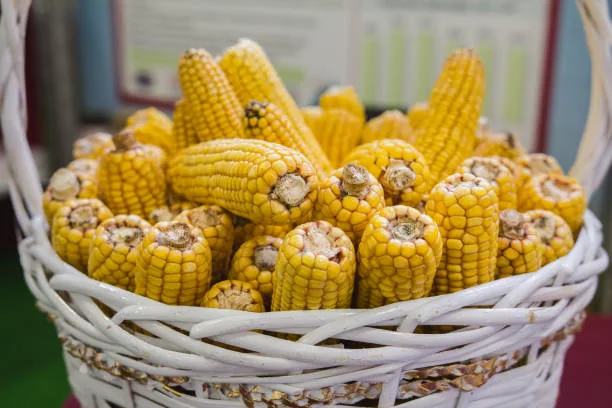
Protein: Maize contains proteins, although the protein content is relatively lower compared to some other grains and legumes. It is an essential nutrient for growth and tissue repair.
Lipids (Fats): Maize contains small amounts of fats, which are mostly unsaturated fats. These fats contribute to the overall energy content of maize.
Water: The moisture content of maize can vary but is generally around 10-15%.
2. Sugars:
- Glucose and Fructose: Maize contains small amounts of naturally occurring sugars, primarily glucose and fructose, which contribute to its sweetness.
3. Vitamins:
- Vitamin B1 (Thiamine): Thiamine is present in maize and is important for energy metabolism and nerve function.
- Vitamin B2 (Riboflavin): Riboflavin is another B vitamin found in maize, supporting various metabolic processes.
- Niacin (Vitamin B3): Maize contains niacin, which is essential for cell function and DNA repair.
- Folate (Vitamin B9): Folate is necessary for DNA synthesis and plays a crucial role during pregnancy.
4. Minerals:
- Phosphorus: Maize contains phosphorus, an essential mineral for bone health, energy metabolism, and DNA synthesis.
- Magnesium: Magnesium is present in maize and is important for muscle function, nerve transmission, and bone health.
5. Phytochemicals:
- Phenolic Compounds: Maize contains various phenolic compounds, including flavonoids and phenolic acids, which have antioxidant properties and contribute to overall health.
- Carotenoids: Yellow maize varieties are rich in carotenoids like beta-carotene, which can be converted to vitamin A in the body. This contributes to the yellow color and provides potential health benefits.
6. Cellulose and Hemicellulose:
Maize also contains cellulose and hemicellulose, which are types of dietary fiber. These components aid in digestion and contribute to the feeling of fullness after consuming maize-based foods.
7. Alkaloids:
Some maize varieties may contain trace amounts of alkaloids, although these levels are typically low and not a major concern for consumption.
8. Lipids and Oils:
While maize itself contains small amounts of fats, maize kernels can be processed to extract corn oil, which is used for cooking and industrial purposes.
Overall, the chemical properties of Nigerian maize make it a valuable source of carbohydrates, essential nutrients, vitamins, and minerals. Its diverse chemical composition contributes to its versatility as both a staple food and an ingredient in various dishes and food products.
Vitamins Components Of Raw Nigerian Yellow Maize/Corn
|
Weight |
100g |
|
Vitamin A, RAE |
55μg |
|
Retinol |
NIL |
|
Carotene, beta |
587μg |
|
Vitamin D |
NIL |
|
Thiamin, B1 |
0.33mg |
|
Riboflavin, B2 |
0.16mg |
|
Niacin, B3 |
2.4mg |
|
|
0.5mg |
|
Folate, B9 (μg) |
28μg |
|
Vitamin B12 (μg) |
NIL |
|
Vitamin C (mg) |
1.7mg |
The Physical Properties of Nigerian Maize (corn):
1. Size and Shape:
Size: Maize kernels are relatively large, measuring between 1 to 2 centimeters (0.4 to 0.8 inches) in length. Their size makes them easy to handle and process.
Shape: These kernels have an oval to oblong shape with a slight curvature. This shape is consistent across most maize varieties.

2. Color:
Variety of Colors: Maize exhibits a range of colors, but in Nigeria, the most common colors are yellow and white. Yellow maize is typically more vibrant and is often used in the southern regions, while white maize is prevalent in the northern parts of the country.
Color Variability: The color of maize can also vary based on factors such as maturity, growing conditions, and genetic variations. Some varieties may even have a mix of yellow and white kernels.
3. Texture:
Seed Coat: Maize kernels have a hard, smooth outer layer called the seed coat or pericarp. This tough exterior protects the inner starchy contents.
Inner Texture: Inside the kernel, the texture is mealy and soft. This inner part contains the majority of the starch, which is the primary source of nutrition in maize.
4. Weight:
Moderate Weight: Maize kernels have a moderate weight relative to their size. The weight can vary depending on factors such as moisture content and size, but they are substantial enough to make them suitable for grinding into flour or meal.
5. Moisture Content:
Moisture Levels: The moisture content of maize kernels can fluctuate depending on environmental conditions and post-harvest handling. To prevent spoilage during storage, maize is typically dried to reduce its moisture content.
6. Density:
High Density: Maize kernels have a relatively high density, meaning they are compact and occupy less space for a given weight. This high density makes them efficient for storage and transportation.
7. Aroma:
Subtle Aroma: Maize kernels have a subtle, earthy aroma, particularly when they are freshly harvested. However, this aroma is not as strong or distinctive as that of certain spices or herbs.
8. Taste:
Mild Flavor: The taste of maize is relatively mild when compared to some other grains. It has a slightly sweet and nutty flavor, especially when cooked or processed. The taste can vary slightly depending on the variety.
9. Sound:
Rattling Sound: When maize kernels are dry and shaken, they produce a distinct rattling sound. This sound is due to their hard and dense nature, which makes them hit against each other when agitated.
10. Husk:
Protective Husk: Maize kernels are enclosed in a protective husk or outer layer, which is often referred to as the maize ear or cob. This husk shields the kernels from environmental factors and pests.
11. Packaging:
Storage in Sacks or Bags: Due to their bulkiness and weight, maize kernels are typically stored and transported in sacks or bags. These containers help keep the kernels dry and safe during handling and transportation.
12. Shelf Life:
Long Shelf Life: Properly dried and stored maize kernels have a long shelf life. This extended shelf life makes maize a valuable staple food in many regions, as it can be stored for extended periods without significant degradation in quality.
These physical properties of Nigerian maize contribute to its versatility in culinary applications, including being a fundamental ingredient in traditional dishes, snacks, and various food products. The combination of size, shape, texture, and other characteristics makes maize well-suited for different cooking methods and recipes, contributing to its importance in the Nigerian diet and agricultural landscape.
Ways to Use Nigerian Maize (corn):
Nigerian maize (corn) is incredibly versatile and can be used in various ways in the country’s cuisine. Here are some common ways to use Nigerian maize:
- Tuwo Masara: This is a popular Nigerian dish made from maize flour. The maize flour is mixed with water and cooked to create a thick, smooth, and stretchy consistency. It is typically served with a variety of soups and stews, such as groundnut soup or okra soup.
- Pap (Akamu/Ogi): Maize is used to make a porridge-like dish called pap or akamu. Maize flour is mixed with water and cooked until it thickens. It is often enjoyed as a breakfast meal and can be sweetened with sugar or served with milk.
- Cornmeal Porridge: Maize flour is used to make a creamy and hearty porridge. It can be flavored with spices, sugar, or fruits for added taste.
- Corn on the Cob: Roasted or boiled maize on the cob is a common street snack in Nigeria. It is often sold by street vendors and enjoyed by people of all ages.
- Corn Flour: Maize can be ground into corn flour, which is used in various Nigerian dishes. It is a key ingredient in making dishes like moi moi (steamed bean pudding) and akara (bean cakes).
- Cornmeal Fufu: Cornmeal can be used to make fufu, a popular Nigerian side dish. It is often served with soups and stews and provides a hearty and satisfying base for these dishes.
- Snack: Chinchinga (Popcorn): Maize is used to make popcorn, which is a beloved snack in Nigeria. It can be flavored with spices or sugar for added taste.
- Cornbread: Cornmeal is used to make cornbread, a delicious and hearty bread that is often enjoyed as a side dish with soups, stews, or grilled meats.
- Cornflakes: Maize is used to produce cornflakes, a popular breakfast cereal. Cornflakes are often consumed with milk and sugar for a quick and convenient morning meal.
- Corn Oil: Maize can be processed to extract corn oil, which is commonly used for cooking and frying in Nigerian cuisine.
- Animal Feed: In addition to human consumption, maize is used as animal feed in Nigeria. It is a crucial component in the diet of livestock like poultry, cattle, and pigs.
- Industrial Products: Maize is used as a raw material for various industrial products in Nigeria, including cornstarch, corn syrup, and ethanol.
These are just a few examples of how Nigerian maize is used in cooking, snacking, and various food products. Its versatility, availability, and cultural significance make it a fundamental part of the Nigerian diet and culinary heritage.
Here are two classic Nigerian recipes using maize (corn) as a key ingredient:
1. Nigerian Cornmeal Porridge:
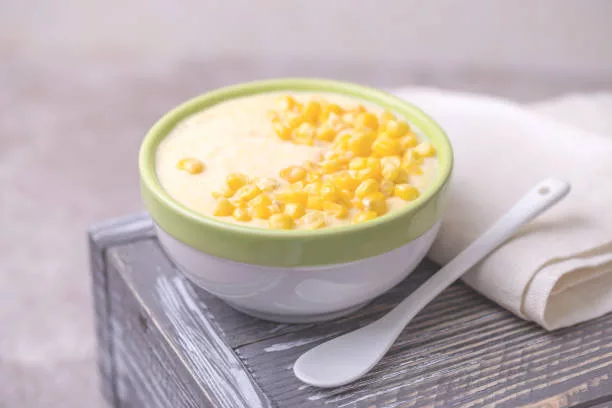
Ingredients:
- 1 cup maize/cornmeal
- 3 cups water
- 1/2 cup milk (optional)
- Sugar or honey, to taste
- A pinch of salt (optional)
- Groundnut (peanut) or coconut, for garnish (optional)
Instructions:
- In a mixing bowl, combine the maize/cornmeal with a cup of water and mix until smooth, ensuring there are no lumps.
- In a saucepan, bring the remaining 2 cups of water to a boil.
- Gradually pour the maize/cornmeal mixture into the boiling water while stirring continuously to prevent lumps from forming.
- Reduce the heat to low and let the mixture simmer, stirring occasionally. Add more water if necessary to reach your desired consistency.
- If using, add milk and continue to simmer for an additional 5-7 minutes, stirring frequently.
- Sweeten the porridge with sugar or honey to taste. You can also add a pinch of salt for balance if desired.
- Serve the cornmeal porridge hot, garnished with groundnut or coconut flakes if you like.
2. Nigerian Moi Moi (Steamed Bean Pudding with Cornmeal):

Ingredients:
- 1 cup peeled and blended black-eyed peas
- 1/2 cup maize/cornmeal
- 1/2 cup vegetable oil
- 1 onion, finely chopped
- 2-3 red bell peppers, blended
- 2-3 scotch bonnet peppers (adjust to your spice preference), blended
- 2 eggs
- 1 teaspoon ground crayfish
- 1 teaspoon ground nutmeg
- Salt and pepper, to taste
- Banana leaves or foil for wrapping (if available)
Instructions:
- In a large mixing bowl, combine the blended black-eyed peas, maize/cornmeal, and vegetable oil.
- Add the chopped onion, blended red bell peppers, and scotch bonnet peppers to the mixture. Mix well.
- Crack the eggs into the mixture and stir until fully incorporated.
- Season the mixture with ground crayfish, ground nutmeg, salt, and pepper. Adjust the seasonings to your taste.
- If you have banana leaves, cut them into square pieces and briefly pass them over an open flame to soften. If not, you can use aluminum foil.
- Place a portion of the mixture onto a square of banana leaf or foil and fold it into a rectangular parcel.
- Repeat the process for the remaining mixture.
- Steam the wrapped parcels in a large pot or steamer for about 45 minutes to 1 hour or until the pudding is firm and set.
- Allow the moi moi to cool slightly before unwrapping and serving. It’s often enjoyed as a side dish with Nigerian stews and sauces.
These recipes showcase how Nigerian maize (corn) can be used in both sweet and savory dishes, adding depth and flavor to traditional Nigerian cuisine. Enjoy!
Potential Side Effects and Things to Remember
When consuming maize (corn) or maize-based products, it’s essential to be aware of potential side effects and some important considerations. Here are a few things to remember:
1. Allergies:
Some individuals may have allergies to maize or corn products. Allergic reactions can vary from mild to severe and may include symptoms such as skin rashes, itching, swelling, or difficulty breathing. If you suspect an allergy, seek medical attention promptly.
2. Digestive Sensitivity:
Maize products, especially those made from maize flour, can be relatively high in fiber. While fiber is essential for digestion, excessive consumption may cause digestive discomfort, including gas or bloating, in some people.
3. Diabetes Management:
Maize is a carbohydrate-rich food, and individuals with diabetes need to monitor their carbohydrate intake carefully. It’s essential to be mindful of portion sizes and consider factors like glycemic index when including maize in their diet.
4. Food Safety:
Proper storage of maize and maize-based products is crucial to prevent spoilage and contamination. Ensure that maize is stored in a cool, dry place, away from pests, and in airtight containers to maintain freshness.
5. Aflatoxin Contamination:
Maize is susceptible to aflatoxin contamination, especially in warm and humid conditions. Aflatoxins are harmful toxins produced by molds that can grow on maize. Consuming contaminated maize can lead to health issues. It’s essential to source maize from reputable suppliers and store it in dry conditions to minimize the risk of aflatoxin contamination.
6. Balanced Diet:
While maize is a staple in many diets, it’s crucial to maintain a balanced diet by incorporating a variety of foods. Maize should be part of a diverse diet that includes vegetables, fruits, protein sources, and other grains to ensure a wide range of essential nutrients.
7. Cooking Methods:
Some cooking methods, such as frying or excessive use of unhealthy fats and oils, can diminish the nutritional value of maize-based dishes. Opt for healthier cooking methods like steaming, boiling, or grilling to retain the nutrients.
8. GMO Concerns:
In some regions, genetically modified maize varieties are cultivated. If you have concerns about GMOs, consider seeking non-GMO maize products or looking for appropriate labeling.
9. Child Safety:
For young children, be cautious of small maize kernels that can pose a choking hazard. Ensure that maize-based foods are prepared in a safe and age-appropriate manner for kids.
10. Moderation:
Like any food, moderation is key. While maize is a nutritious and versatile ingredient, excessive consumption of any single food can lead to an imbalanced diet.
Remember that individual reactions and sensitivities can vary, so it’s always a good practice to consult with a healthcare professional or a registered dietitian if you have specific concerns or dietary restrictions. Enjoying maize in a balanced and safe manner can be a delicious and nutritious part of your diet.
In conclusion, Nigerian maize (corn) is a versatile and important staple in the country’s cuisine and agriculture. It offers numerous nutritional benefits, including carbohydrates, dietary fiber, vitamins, and minerals. Maize is used in various traditional dishes, snacks, and food products, contributing to the rich and diverse flavors of Nigerian cuisine.
However, it’s essential to be aware of potential side effects, such as allergies, digestive sensitivity, and aflatoxin contamination, and to consume maize in moderation as part of a balanced diet. Additionally, consider individual dietary needs and preferences, including diabetes management and GMO concerns.
Ultimately, Nigerian maize plays a vital role in the country’s food culture and economy. When used thoughtfully and safely, it can be a delicious and nutritious addition to your meals, offering a taste of tradition and the nutritional benefits of this versatile grain.
References
- Adegbola, J. A., & Babalola, O. O. (2019). Proximate, mineral, and antinutrient compositions of maize (Zea mays) varieties commonly consumed in southwestern Nigeria. Food Science & Nutrition, 7(4), 1269-1276.
- Ogunmoyela, O. A., & Ogunmoyela, O. A. (2017). Evaluation of the nutritional and phytochemical properties of maize (Zea mays) grown in Nigeria. African Journal of Food Science and Technology, 8(4), 108-116.
- Adeyeye, E. I., & Adebayo-Oyetoro, A. O. (2018). Physicochemical and functional properties of maize (Zea mays) varieties cultivated in Nigeria. Cogent Food & Agriculture, 4(1), 1492636.
- Fagbemi, T. N., & Oshodi, A. A. (2010). Nutritional evaluation and functional properties of maize and sorghum starches and their application in noodle production. Journal of Food Science, 75(8), E460-E467.
- Osundahunsi, O. F., & Aworh, O. C. (2002). Proximate composition and functional properties of flour produced from two varieties of tigernut (Cyperus esculentus). Plant Foods for Human Nutrition, 57(4), 365-374.
- Adeyeye, E. I., & Akindahunsi, A. A. (2017). Chemical composition and physicochemical properties of maize (Zea mays) and tigernut (Cyperus esculentus) flour blends. Journal of Food Measurement and Characterization, 11(1), 49-58.
- Uzochukwu, S. V. A., & Adebowale, A. A. (2019). Nutritional and physicochemical properties of maize-melon composite flour and sensory evaluation of cooked paste. Food Science & Nutrition, 7(4), 1239-1246.
- Ijarotimi, O. S., & Keshinro, O. O. (2012). Nutritional composition, phytochemical and functional properties of underutilized Nigerian maize (Zea mays) varieties. Journal of the Science of Food and Agriculture, 92(13), 2705-2712.
- Olugbuyi, O. A., & Adeyeye, E. I. (2018). Comparative evaluation of the nutritional and functional properties of maize and pigeon pea composite flour. Food Science & Nutrition, 6(8), 2209-2215.
- Osundahunsi, O. F., & Aworh, O. C. (2003). Functional properties and biscuit making potentials of sorghum-wheat flour composite. International Journal of Food Science & Technology, 38(6), 703-709.

